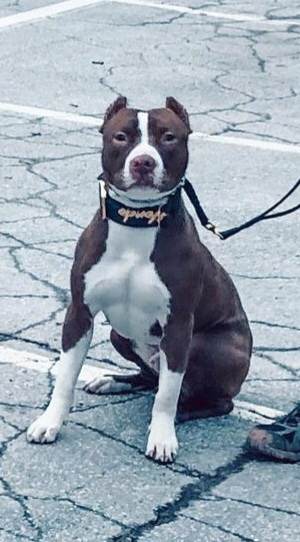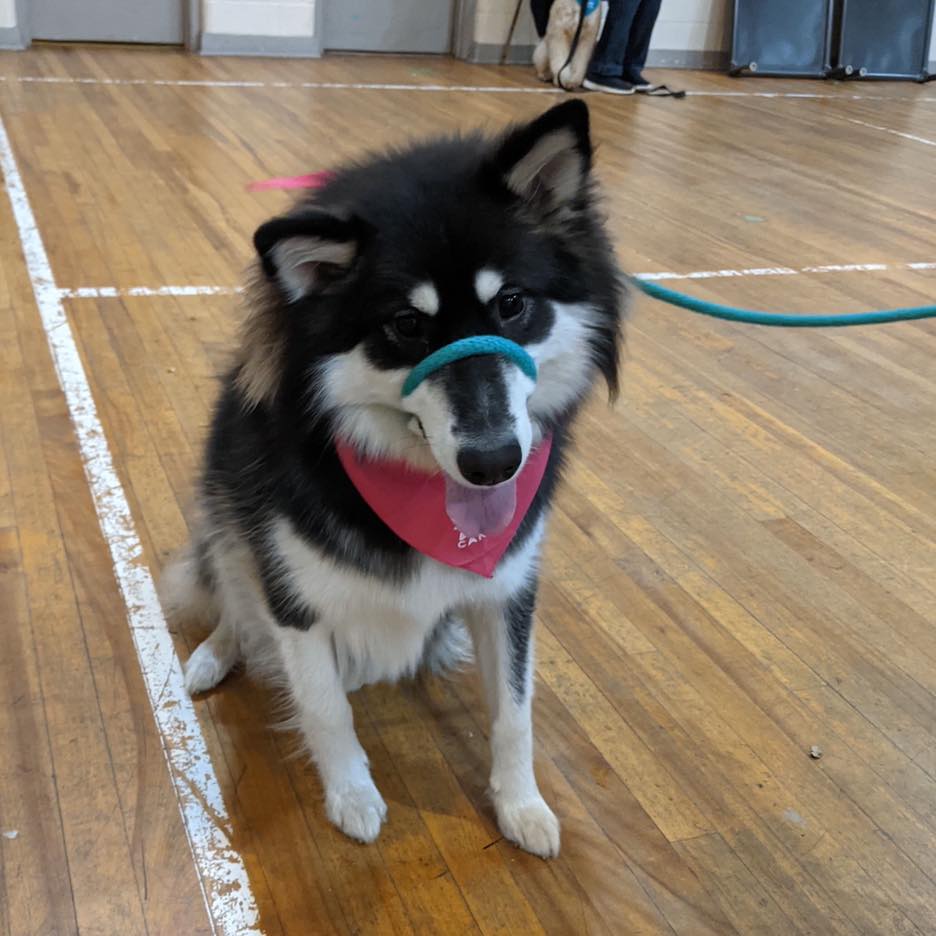by The Crunchy Canine | Dec 14, 2022 | TESTIMONIALS

“We rescued our boy Hondo about 8 months ago and he had zero training.
He was wild, couldn’t walk him on a leash without one of us getting so frustrated that walks were no longer enjoyable.
After reaching out to crunchy canine for in home training, it was the best decision we did for
Hondo and us.
Hondo now can walk on loose leash, walk on our side and will no longer lash out at other dogs or squirrels on walk.
Katherine was very professional and patient with us and Hondo throughout all of our training.
I’d highly recommend hiring the crunchy canine for your training needs!
And free social obedience classes are a bonus!”
Rej and Simona with Hondo in Hamilton
by The Crunchy Canine | Feb 14, 2022 | TESTIMONIALS
“

We originally came to the Crunchy Canine for help with Luna’s over excitement and extreme pulling when we walked her. At one point, her pulling and excitement got so bad, walking her became a chore that no one enjoyed or looked forward to.
We tried a multitude of tools (leash, slip-lead, gentle-leader etc. etc. etc…) but nothing seemed to register with Luna, or, she would get better for a bit and then get used to whatever tool we were using and it was back to square one. Once we started to advance her training and worked one on one with Katherine, we decided to switch her over to the remote collar. After the first week, we saw a significant change in Luna – for the better – she was responding more, being more aware of us and what we wanted from her. She was even noticeably starting to enjoy her walks more, as she never really enjoyed walking with the gentle leader on or any of the other tools we tried. But with her collar, she genuinely seemed so much happier. She had more freedom, less restraint but more control and consistency with her training. There was now a very clear, “black and white” approach to our training and more structure. Her recalls started to improve to the point where after the first few weeks, she was coming on command, staying by our side and with little to no motivation from the e-collar, she just started to understand what we expected from her more. We are improving each and every day and for the first time in a long time, we are extremely excited and hopeful that the remote collar is going to bring Luna to a point where she can have the best life possible. We are confident that our choice to switch to the remote collar was the right choice and one we will forever be thankful for.
A lot of people are apprehensive of the remote collar at first… but from our experience and after having used NUMEROUS tools, I can confidently say that the remote collar was the best decision we have ever made, besides the day we decided to get our Luna, of course ! If you’re thinking about making the switch, do it! This tool can seriously change yours and your dogs life, it did for us!”
Jordan with Luna from London, Ontario
by The Crunchy Canine | Feb 11, 2022 | TESTIMONIALS
“We were looking for a trainer to help with off leash reliability and we ended up with some much more!! We did private lessons and Katherine was able to help us with so much: resource guarding, reacting at the door, the vacuum, and other dogs, crate training, loose leash walking, settling in public. We learned so much from our training, it has been a priceless experience. Even since we finished our training, they have remained accessible for follow up help. They were always punctual and open with communication. We’ve had such amazing results and are so glad we chose Crunchy Canine! Our boy even gets fun off leash time now!”

by The Crunchy Canine | Jan 17, 2022 | BLOG
If you are a family with kids and are considering getting a new dog, we hope this question has crossed your mind! We see so many people get dogs that are just not a good fit for families and all because they maybe met one dog of that breed that they really liked, or they just like the look of the dog! It is incredibly important to do your research and really get a feel for what you are signing up for! Just because you met a really nice, friendly, and calm German Shepherd does not mean that all German Shepherds will be the same.
So to save you some time, we have compiled our list of favourite breeds for families with children!
Active families with young children – For active families with young children we recommend Beagles or Labrador Retrievers. Both breeds are known to have easy going dispositions, friendly, should not have stranger danger, and love to get out and have some fun. Both have their own unique instincts based on what they were bred for but they should be adaptable to family life. We feel strongly that if you have a household with people coming and going, you should steer clear of breeds that genetically are predisposed to have stranger danger or be weary of people who are not in their inner circle. Labs and Beagles should welcome guests into your home with a wagging tail, enjoy being around kids, and always be up for adventure! Of course your Lab will want to retrieve things, and your Beagle will want to sniff, but neither of those traits should affect them being an amazing family pet! Plus both are super cute! Unfortunately, both do shed though. When choosing a Lab breeder, make sure you pick one that does not breed for colour (and certainly no dilute colours). We prefer Black labs and Yellow labs over Chocolate for personality and trainability. Golden Retrievers are another fan favourite and we do love them, but over the past few years we have seen breeding go down hill so if you can find a really good breeder then they are also a great choice!
Families with young children who are not overly active – If you have young kids but you’re family is not overly active you need to make sure you can provide your new dog with suitable exercise. However, there are two of our favourite breeds that will require less exercise than most. We absolutely adore the Havanese and King Charles Cavalier Spaniels. Both breeds are small, non-shedding, and low energy. In fact they were basically bred to be lap dogs. Unlike many other small breeds, they should be friendly, easy to train, and up for adventure but also happy to spend the day bingeing Netflix. If you are looking for a larger breed dog you can luck out with a lower energy lab if you go with an English or “show” lab, and if you are open to a giant breed the English Mastiff or the Leonberger are our favourites.
Families with young children who want a “doodle” type dog – Doodles are all the rage these, but there are so many bad “breeders” out there that we strongly recommend you consider other breeds instead. While the Doodle type dogs are cute, they are often very high energy, can be neurotic, prone to running away, and just overall challenging to train especially when you have young kids in the house. If you like the look we would recommend a Portuguese Water Dog, Barbet, or Standard Poodle. You might even consider a Wheaten Terrier if you are up for the challenge of a terrier breed! If you do go for a Doodle type dog, stick with the original Labradoodle or Goldendoodle. There are some nice dogs who are other Doodle type mixes but keep in mind you get both the best and the worst of the breeds so that in itself can be very challenging!
Families with young children who want a dog for protection – Unless you are buying a dog to train for protection then avoid this train of thought. We are not saying that a German Shepherd cannot be a good family dog. We are saying they were not bred for that and unless you understand the breed really well and are up for the challenge then you might be very disappointed. We see so many Shepherd type dogs available for rehoming around the 6 months mark and many from families with young kids. Another trend we are seeing is power breeds like Cane Corsos, Rottweilers, and Bully type breeds common among families with young kids. Again, we are not saying it wont go well, but we very often see it not go well. These dogs may be great with your family but are often prone to stranger danger, resource guarding and dominant behaviour around lower standing members of the family.
So to sum that up…for families with kids we love:
- Labs
- Beagles
- Golden Retrievers
- Havanese
- King Charles Cavalier Spaniels
- English Mastiffs
- Leonbergers
We hope this helps you on your journey of selecting the right dog for your family!
by The Crunchy Canine | Oct 30, 2021 | TESTIMONIALS
Milo | Dog Training Brantford
“Tara was really great! Very personable and knowledgeable. She really listened to our concerns and offered helpful suggestions. She came with a plan but was also willing to alter based on our needs.”
Sarah with Milo, Brantford, ON



